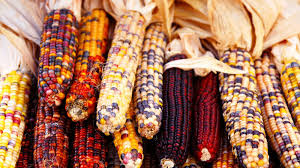A BRIEF HISTORY OF THANKSGIVING
After
a sixty six day journey seeking religious freedom, the Pilgrims arrived in
Massachusetts, far from their destination along the Hudson River.
 |
The Mayflower left England with 102 passengers. Of that only 35 were seeking freedom from the Church Of England which they thought was corrupt. The remainder came seeking wealth. |
With no
suitable place to land most of the Pilgrims spent the first winter on board the
Mayflower where many died from hunger and disease.
 |
The Mayflower steered off course of the Jamestown settlements and landed far north at Plymouth, Massachusetts. |
In
early spring when they arrived on land they were surprised to be greeted by an ‘Abenaki
Indian’ who already spoke English. A few days later he returned with ‘Squanto’ a
Patuxet Indian who also spoke English*.
 |
The Pilgrims were surprised to be greeted by English speaking Native Americans. |
Squanto took pity on the new settlers and taught them how to farm, gather wild berries, fish in the rivers and hunt. He also taught them how to avoid poisonous plants.
 |
When Columbus "discovered" the new land, American Indians had been farming here for 4 thousand years. |
Squanto
forged an alliance between the Pilgrims and the local Indian tribe, the
Wampanoag.
The
main three farm crops of the Wampanoag were corn, beans and squash. Wampanoag
also farmed watermelon and sunflowers, gathered blueberries, cranberries,
strawberries and hunted game.
 |
Grown in the same plot, the corn would grow tall, the beans would grow up using corn as a trellis and the pumpkins would ramble on the ground where its fruit was protected from burning. |
They taught the pilgrims how to collect maple sap
and turn it into maple syrup.
 |
Maple sugar is likely the oldest agricultural product in North America. Before the Europeans arrived, native people had already perfected the craft. |
After
the first successful corn harvest in November 1621 the leader of the Pilgrims,
Governor William Bradford declared a celebration feast, which today is known as
the First Thanksgiving.
 |
It was the successful harvest of corn that saved the early settlers from future winters of starvation. |
Although
there were earlier gatherings to “Thank God Almighty” in the colonies, one on
December 4, 1619, it is the Pilgrims Thanksgiving we remember today. Thanksgiving gatherings were days of prayer, whereas the pilgrims included feasts.
 |
The Wampanoag Indians and the Plymouth settlers remained friends for over 50 years. Later arriving Puritans seeking land and wealth would bring an end to peace. |
The 50 surviving Pilgrims and 90 Wampanoag Indians had a three day feast which included five deer donated by the Wampanoag chief.
 |
Squanto was the main guest of honor at the First Thanksgiving, |
Throughout the decades afterwards Americans would occasionally celebrate a ‘National Day of Thanksgiving’.

In 1863 during the Civil War, President Abraham Lincoln established our annual Thanksgiving Day on the fourth Thursday of every November.
 |
Thanksgiving has been an annual event every year since 1863. |
*Before the arrival of
the Pilgrims, Squanto and many other members the Patuxet tribe were captured by
the British and brought back to England as slaves. The Patuxet tribe members
remaining in America died from small pox transmitted by the English. Squanto who
now spoke English was able to escape and return to America as a stowaway on
another ship. Squanto died on November 30, 1622. He was buried at Burial Hill, Plymouth, MA.
 |
Which brings us to our modern Thanksgiving day celebrations. |
Happy
Thanksgiving, James
No comments:
Post a Comment